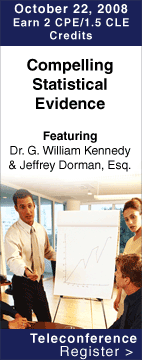
| FLP planning in the wake of recent taxpayer victories Last March, Mirowski v. Commissioner, the U.S. Tax Court delivered a long-awaited victory to taxpayers and their appraisers when it found that a family limited partnership (FLP)—formed just days before the founder’s death—had legitimate, non-tax business purposes, sufficient to meet the exceptions under IRC Sec. 2036 and withstand an IRS attack. Key to the court’s ruling: 1) no one expected the founder to die so quickly; 2) there was no provision to use the FLP assets to pay estate or gift tax liabilities (even though the latter were significant). Would the Astelford, Holman and Gross FLPs withstand a similar attack? In recent weeks, we’ve also covered two gift tax cases, Holman v. Commissioner (May 2008) and Gross v. Commissioner (Sept. 2008), in which the formation and funding of FLPs withstood attacks by the IRS as indirect gifts. In a third case, Astleford v. Commissioner (May 2008), the taxpayer convinced the court to adopt significant, multi-level discounts for lack of marketability and control in valuing the FLP. Given the IRS’s sustained efforts to disable FLPs as tax-planning devices, however, the Service may likely attack these FLPs when their founders die, to recover the full value of the assets under Sec. 2036. What planning pointers can taxpayers glean from Mirowskito ensure more FLP victories in the estate context? That’s the very question Steve Akers of Dallas’ Bessemer Trust Co., NA, addresses in his current article, “Family Limited Partnership Planning Update in Light of Three Recent Judicial Decisions,” published in the Autumn 2008 Insights, by Willamette Management Associates:
What helped Mirowski estate pass the “smell test,” Akers says, is the daughters’ credible testimony that their mother established the FLP for the significant non-tax reasons and not just to get the valuation discounts. “Whether other judges will agree with that approach is yet to be seen.” Cautious planners will continue to “be sensitive” about having the FLP founder serve as sole general partner or manager, Akers says, and they should pay attention to distributions—especially post-mortem payment of tax liabilities. Finally, operating the FLP “in a way that is consistent with the stated nontax reasons” could be a deciding factor. Akers’ article is one of several in the current Insights, focusing on “Gift and Estate Tax and Intergenerational Wealth Transfers.” Archived articles will be posted to BVResearch™, which now boasts over 265 articles from Insights, 60 from Mercer Capital’s Value Matters, and more. CFA weighs in on the financial crisis and growing calls to rollback FAS 157 It’s no secret that many think that FAS 157 helped fan the flames of the current financial crisis (see: More blame for FAS 157 in current economic crisis?) while others assert that it confuses many valuation issues without sufficient guidance, especially on its seemingly counterintuitive valuation requirements. Indeed, just this week, in a letter to SEC chairman Christopher Cox, The American Bankers Association asked that the “SEC use its statutory authority to step in and override the guidance issued by FASB.” Another take: In a letter recently sent to Congressional leaders and the Securities and Exchange Commission (SEC), the CFA Institute Centre reinstated its position for an end to the calls for rolling back fair value reporting. In brief, the letter notes that:
How will the financial crisis impact the BV profession? It’s a question that we recently put to a host of industry experts and (as we expected) their hypotheses proved to be both compelling and insightful. For the full story, you’ll have to take a look at the full article in the next (November 2008) BVU. In the interim, below are a few of the comments offered by the BV experts that we queried:
Statistical models can make all the difference To refresh and refine your use of statistical models, regression analysis, and market event studies, be sure to tune into BVR’s next teleconference, “Compelling Statistical Evidence: Mining, Modeling, and Presenting Quantitative Financial Evidence to Juries,” featuring William Kennedy, Ph.D, CPA/ABV of St. Louis’ Anders Minkler & Diehl, LLP, and Jeffrey Dorman, Esq. with the Chicago office of law firm Freeborn & Peters, LLP. The teleconference takes place Wednesday October 22, 2008; to register, click here. Just how important are statistical models? Just take a look at some recent cases where effective statistical analysis, including market event studies, became the “make or break” evidence, especially in cases concerning securities litigation and lost profit/economic damages:
The last case was—until its reversal for lack of reliable statistical evidence, the largest jury award for economic damages ever. All of these case—especially in light of the securities and loss litigation that is certain to come out of the current economic spiral—demonstrate just how important it is for valuation analysts to present compelling and understandable statistical models to a judge or jury (and assist their attorneys in preparing the evidence for deposition and trial). Reminder: Copies of all cases are available at BVLaw™, and the case abstracts are available by subscription at BVLibrary™.)
|
To ensure this email is delivered to your inbox,
please add editor@bvwire.com to your e-mail address book.
We respect your online time and privacy and pledge not to abuse this medium. To unsubscribe to BVWire™ reply to this e-mail with 'REMOVE BVWire' in the subject line or click here.
Copyright © 2008 by Business Valuation Resources, LLC
BVWire™ (ISSN 1933-9364) is published weekly by Business Valuation Resources, LLC
Editorial Staff | Advertise in the BVWire | Copyright Notice
|
|



